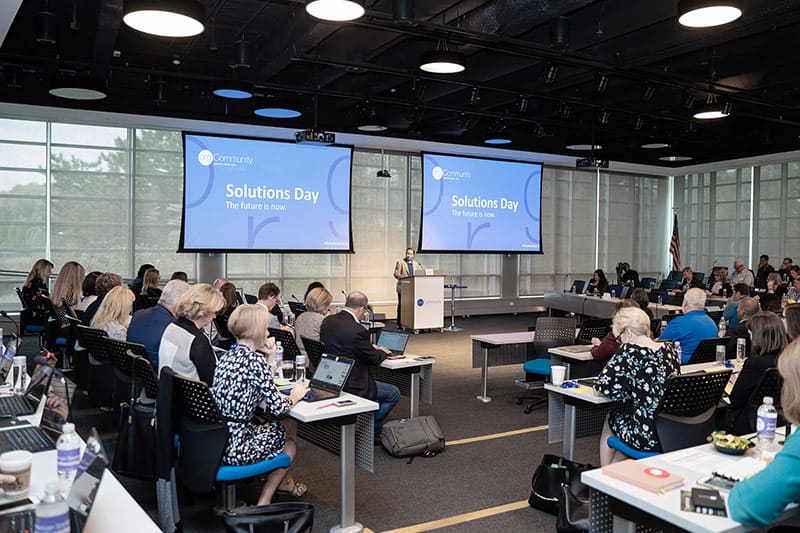 Why did I use this cute pup to illustrate my post? You know what they say about babies and dogs, they get people to pay attention, and this message is important.
Why did I use this cute pup to illustrate my post? You know what they say about babies and dogs, they get people to pay attention, and this message is important.
Several weeks ago, I wrote about the results of a survey .orgSource conducted. That’s another reason for the dog. Survey results tend to make readers’ eyes glaze over. But stay with me. I want to talk about bringing a breath of fresh air into stale scenarios and looking at routines through new eyes.
The survey goal was to learn how associations are being impacted by the pandemic and how they are preparing for the future. Based on the responses, most groups are navigating through this disruption. Some, especially those with a strong digital infrastructure, more successfully than others. That should be a reason to bring out the cake, champagne, and fireworks. But put a hold on the celebration.
There is a troubling countervailing trend. Although 73% of participants agreed that the pandemic is accelerating changes in the role of associations, their underlying business model, and their strategic direction. And 54% strongly agreed that shifts in the environment will threaten the viability of many groups. Here’s the disconnect. Just under half, or 40%, did not foresee long-term revisions to their product portfolio. Almost 60% believe their membership models will resume pre-pandemic patterns, and 41% saw in-person networking opportunities returning to the status quo. Quite a few participants also commented that their mission and vision would remain unchanged.
Maximize the Positive Face of Disruption

My inbox is full of articles explaining the need for resilience. Yet, these statistics tell me that many leaders are not fully absorbing that message; or they are interpreting it in a time-limited way. THE PANDEMIC WILL NOT BE THE LAST DISRUPTION. (Sorry for that. Focus on the dog for a moment if you need to.) Disruption is a way of life in the digital marketplace.
In fact, COVID-19 isn’t a disruption in the original sense of the concept. At the core, disruption is characterized by innovation. The idea is believed to have been outlined in a paper (worth a read) by Clayton Christensen and Joseph Bower published in 1995 in the Harvard Business Review. The authors were describing the phenomenon that occurs when a small company brings a product that is both novel and revolutionary to market and challenges established players by filling gaps in service. Initially, the new offering may be ignored because the public or the product isn’t quite ready. But eventually, the improved option becomes so popular that it renders its competition obsolete. That interval between coming to market and annihilation of the competition is rapidly shrinking.
Why do association leaders need to care? Aren’t these upheavals occurring primarily in technology? Isn’t staying current with the trends in our own industry enough? Didn’t most of us successfully make the shift to virtual work and meetings? Here are three good reasons to pay attention:
- The digital marketplace is changing how people work, the skills needed to stay employed, and options for professional success. You can’t support your members if you’re just riding the curve, you need to be ahead of it.
- New ways of working, i.e., freelance and contract, and perceptions concerning professional affiliations are having an impact on how employees value membership. Associations must understand these cultural shifts and adapt.
- Options for professional development are rapidly expanding, and the value of traditional credentialing may be in decline. To keep pace, associations need to develop robust education portfolios that address new demands.
Use Innovation to Enhance Stability
A scary thing about disruption is the element of surprise. It’s like participating in a challenging sport, say mountaineering or sailing. A thousand things could spell disaster, but you don’t know which of them might be headed your way. That’s why I’m concerned. I don’t see enough leaders taking steps to prepare. Our survey revealed that many organizations believe they are lacking these and other core building blocks for change: effective governance structure, cultures grounded in trust, and a priority on innovation.
Innovation is where I’d like to focus. It’s an area that’s given limited attention in the scope of organizational activities. Yet as the positive face of disruption, it is also a strategy to remain stable in a volatile environment. Innovation isn’t so much about invention as it is about being inventive. It begins with an attitude that encourages questioning, curiosity, and creative problem-solving.
When teams consistently test approaches, evaluate results, and search for improvement, associations evolve. The capacity and will to change create momentum. An innovative culture generates other attributes that are hallmarks of a resilient business such as adaptability, risk tolerance, and change management.
Discover Available Resources
The good news is that you already have the resources needed to nurture creativity. Our Association 4.0 books, Positioning for Success in an Era of Disruption and An Entrepreneurial Approach to Risk, Courage and Transformation, include advice from leaders across the association community on how to harness attributes that are readily available to develop a more innovative organization.
Create Space
 Tracy King, CEO and Chief Learning Strategist, InspirED, notes that simply giving permission to experiment can have a significant impact:
Tracy King, CEO and Chief Learning Strategist, InspirED, notes that simply giving permission to experiment can have a significant impact:
“Teams need space to innovate,” King says. “Allowing for learning through failure creates the freedom to solve problems instead of checking tasks off a list. We must ruthlessly sift the challenges from the temporary distractions and seek the nuggets of truth in every successful disappointment. Incremental innovation is smart. So is listening deeply to the market and using MVPs to recalibrate. These are strategies that allow associations to see a real-time picture of their members’ needs.”
Fill Gaps
Even the most bureaucratic groups can carve out space for new thinking. Brent Gibson, Chief Health Officer at the National Commission on Correctional Health Care and Managing Director NCCHC Resources, Inc., described how NCCHC Resources became the nimble partner for its more traditional parent organization:
“Deliberately identifying new or additional customer services is one path that associations and other nonprofits can take toward growth.” Gibson says, “historically at NCCHC, all technical assistance was based on support for accreditation, and we didn’t focus on margin. It became evident that, due to the complexity of the operating environment, there were services outside our realm of expertise that were not being provided. We were perfectly positioned to contract with experts who could solve these complex problems for our customers. You have a choice to either say, we can’t help you or you can figure out how to fill in the missing pieces. It may take some mental wrangling. But the bottom line is, don’t be afraid of a calculated risk.”
Nurture Talent
My business partner, Kevin Ordonez, and I never fail to be amazed at the number of “undiscovered innovators” we find during our consulting projects. People who are natural problem-solvers sometimes go unnoticed because they aren’t in visible positions or they have been finding solutions without fanfare or recognition. Identify those fixers and give them the opportunity to be creative in new and more impactful ways.
These are additional strategies that encourage innovation:
- Be a leader who values curiosity and invites questions
- Recognize the problem-solvers
- Provide a regular forum for brainstorming and encourage ideas from all employees
- Become a culture that responds to suggestions with “yes, and . . .”
- Don’t let expedience stifle improvement
- Dedicate some budget to experimentation
- Have the courage to change before change is comfortable
And, last but not least, if you need to grab your audience’s attention to convince them to consider a critical initiative. Don’t be afraid to feature a cute dog.


